Divine Depictions: Celebrated Paintings of Jesus Christ
- Jesus and Art
- Popular Paintings of Jesus
- The Last Supper (1498) by Leonardo da Vinci
- Salvator Mundi (1519) by Leonardo da Vinci
- The Transfiguration (1520) by Raphael
- The Last Judgment by Michelangelo
- El Greco, Christ Carrying the Cross (1580)
- Caravaggio, Supper At Emmaus (1601)
- Diego Velazquez, Christ Crucified (1632)
- Paul Gauguin, The Yellow Christ (1889)
- Crucifixion by Francis Bacon (1933)
- Christ on the Cross by Salvador Dali
- FAQs
Jesus is one of the most famous people in history. Over the centuries, thousands of Jesus paintings and Jesus drawings have been made. Yet, no one has ever seen what Jesus really looks like. Amateur artists and masters have created art of Jesus Christ, leaving many images of the divine being behind.
Jesus and Art
The oldest Jesus painting we know was discovered in Syria around 235 AD. The painting shows Christ in his youth without facial hair and in an authoritative manner. The image shows Christ with short hair, wearing a tunic and pallium, the clothing of a Greco-Roman philosopher. Later versions show him as a slightly older man with a full beard.
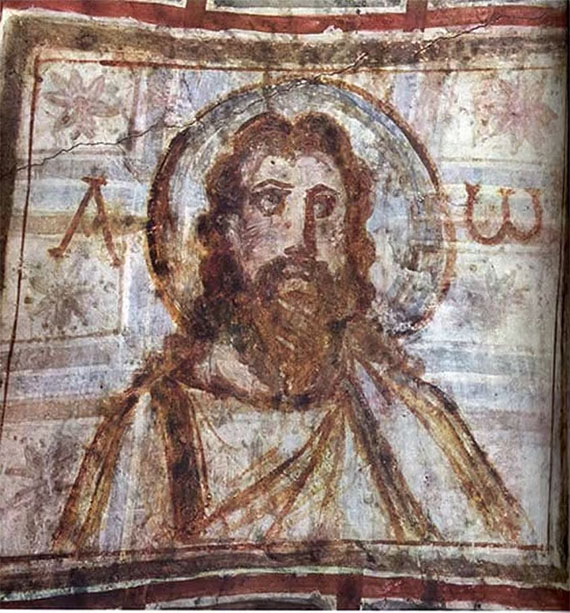
This is the first bearded image of Christ. It's a mural from the Commodilla catacomb. Christian artwork from earlier times in Rome depicted Jesus as the Good Shepherd. He was young, beardless, and wearing a short tunic. In the 4th Century, Jesus began to be represented as a man with an identifiably Jewish look, a beard, and long hair.
This was a style that Romans did not wear. The symbols at either end are Alpha and Omega, which signify "I am both the beginning and the ending."
Jesus was probably born in Galilee, a region located in the Middle East. He would have most likely had curly brown hair and darker skin. He is usually portrayed as a European man with light hair and blue eyes.
It would have been counterproductive to depict him as a black person because American and European Christians use their religious beliefs to oppress people of other racial backgrounds.
The Nazis in Germany also tried to portray Christ with an Aryan look instead of a real Jewish appearance. Warner Sallman's image of Christ was also prevalent in 1940 and was used on many items and products. This image is a misrepresentation of the man of that time and place.
Popular Paintings of Jesus
Many painters have captured the essence of Jesus despite not having any clues about what his natural appearance might have been. The context and the expression of Jesus' face, whether it's a portrait or one of many Jesus-on-cross paintings, has managed to give a sense of what the painting represents. We will look at some of the most famous Jesus paintings throughout history.
The Last Supper (1498) by Leonardo da Vinci
The Last Supper, painted in the 1490s, was part of an agreement signed by Ludovico Sforza to restore the church's structures and the church itself. Jesus warns his disciples at the Last Supper on the mural that one of those present will betray him. The original is mainly damaged due to environmental factors, despite multiple attempts to repair it over the years.
The artwork began to flake off and degrade as early as the 1500s. After only 50 years, it was no longer a pristine work of art. Early attempts to repair the artwork only made it worse.
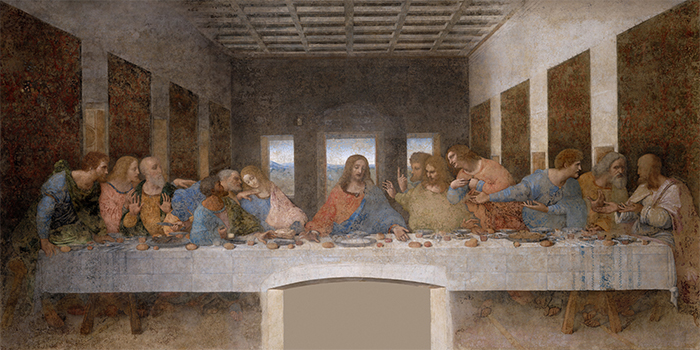
Allied bombings in World War II caused severe vibrations which shook the structure and damaged it severely. By 1980, the restoration project had been underway for 19 years, and much of the original paint was already gone. In 1652, when a new door was constructed as part of repairs to the original, a section on the bottom left of the painting, including Jesus's foot, was damaged. Scholars believe that each of the members was modeled on an actual individual.
Leonardo da Vinci wanted Judas to be a hardened criminal with cynicism. Leonardo da Vinci is believed to have searched the Milan prisons for a model suitable for Judas.
Salvator Mundi (1519) by Leonardo da Vinci
Leonardo Da Vinci is a multi-talented Italian Painter famous for his inventions, innovations, and art. Leonardo Da Vinci's fame as a painter was mostly earned over the next four centuries. He is still regarded as one of the greatest artists in Western art. According to records, King Charles I was the first to own this painting. It was sold at auction by the son of Buckingham in 1763. Sir Francis Cook, a British art dealer, purchased it in 1900.
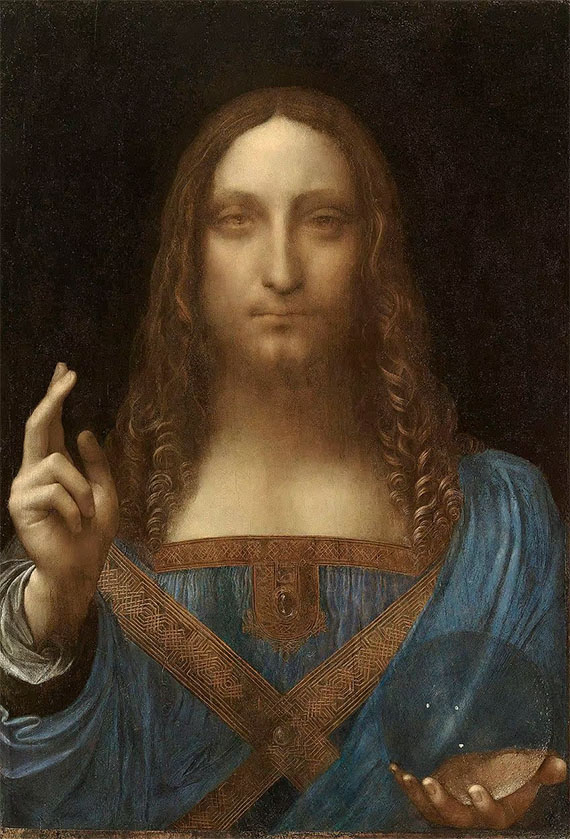
The family of Sir Francis Cook sold the painting for PS45 in a later auction. It was thought to be a replica of a lost da Vinci by another artist for many years. However, after cleaning it in 2006, the numerous techniques indicative of his work became evident. Despite its fame as the most expensive artwork in the world, many art critics disagree on whether Leonardo da Vinci painted it.
Christ is shown as the world's Savior. The image shows him in Renaissance clothing, holding a crystal globe in one hand and raising his hand to bless the world.
The Transfiguration (1520) by Raphael
Raphael’s Transfiguration, his final work, is undoubtedly one of his best. Cardinal Giulio De Medici, a member of the banking family with the same name, commissioned the painting. It was originally intended for France's Narbonne Cathedral, where it would serve as the center entablature. However, it is now housed in the Vatican Pinacoteca Vaticana. The painting was not sent to France after Raphael died. In 1523, the painting was given to Blessed Amadeo Church instead of hanging it on the cathedral's main altarpiece.
It was brought to the Louvre by French soldiers during Napoleon's campaign in Italy in 1797.

The base level of this artwork shows two opposing images. The composition has Christ on one side with his ability to redeem. The upper part of the composition represents the pure, symmetrical, and pristine elements of the Universe.
The lower part of the painting depicts Man, his flaws, and the chaos and darkness surrounding him. It was his last piece of art, and he continued to work until the end.
The stunning art of Jesus was cleaned in the mid-1970s. It was discovered that the artist had completed most of the painting himself. Only a few beings on the bottom half were painted by his assistants.
The Last Judgment by Michelangelo
Michelangelo created this massive masterpiece, which covers the entire wall of the Chapel altar. The sheer size of the work, the impracticality, and the large number of people he included took Michelangelo four years to complete.
The fresco was completed when he was 67. He started his work about 25 years after the chapel's construction.
The entire painting depicted the men as naked. However, the draperies were later painted over the areas deemed offensive.

The piece received mixed reviews from critics. Some criticized the nudity and muscle of the figures, while others praised it. The fresco depicts the day Christ returns to Earth to deliver Mankind's ultimate judgment.
Christ and his Saints judge the souls' worthiness as they rise to the heavens. The painting was completed under Pope Paul III despite the fact that it had been ordered by Clement VII.
The conservative views held by the Pope of that time would have played a major role in the decision to have the painting changed to a more modest depiction of human form.
El Greco, Christ Carrying the Cross (1580)
El Greco painted many Jesus paintings on the cross during his long career in Spain. The only thing that makes this one different is that the background and context are not discernible. Christ is the sole subject of the painting.
Jesus is shown carrying the entire weight of the Cross on his way to his own Crucifixion. This image captures Christ's deep contemplation as he prepares to die to save mankind from sins.
El Greco was a truly unique artist, combining the elements and ideals of three different eras.

They possessed a new spirit in terms of the design of the body. Greco's forms were often long and stretched, almost flowing. His Romantic paintings focused on how Man suffers and loves through pain and contention.
El Greco was also influenced by Renaissance ideals and techniques, particularly the idea that the ideal human body was a purified connection to divinity. Greco's works portray figures associated with this divine, iconoclastic condition of being.
El Greco’s figures were often distorted and extended, as opposed to the perfect proportions and natural shape of Renaissance body shapes.
Caravaggio, Supper At Emmaus (1601)
Caravaggio is an Italian painter who combined dramatic lighting with a study of human emotion and condition. His paintings helped to shape the Baroque painting style. He is regarded as one of the most important Western artists.
The Supper at Emmaus is one of Caravaggio’s most famous religious paintings. It depicts the moment the risen Christ appeared to Cleopas and Luke in the village of Emmaus.
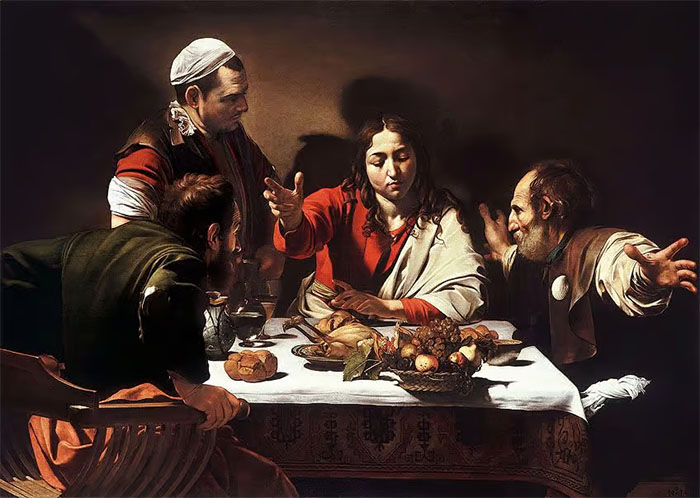
The Jesus painting demonstrates the exact moment the two apostles realized they were witnessing something supernatural. Christ's beardless appearance and the billowing clothing he wears hide any signs of his Crucifixion wounds. The groom's face has darkened, and his brow is smooth. He appears to be unaware of what is going on.
This picture is special because it shows life-sized figures against an empty black background. On the table is a still-life of a dinner. The food basket is perched precariously, as it was in the world of these disciples.
This scenario is a good example of the unexalted nature since Jesus, as a human being, has become unrecognizable to his disciples while affirming and transcending his humanity.
Diego Velazquez, Christ Crucified (1632)
Diego Velazquez, a Spanish Golden Age painter and artist, was active during the 17th century. He is often considered to be its most significant figure. He was the royal painter for King Philip IV and is known for his portraits. Velazquez painted this picture of Jesus at the cross in the middle years of his career. It shows the moment after his death. The artwork is notable for the absence of narrative elements aside from the cross.
This painting, a work of exceptional uniqueness, mastery, and majesty combined with calm grandeur, is considered a watershed in Velazquez’s creative growth.
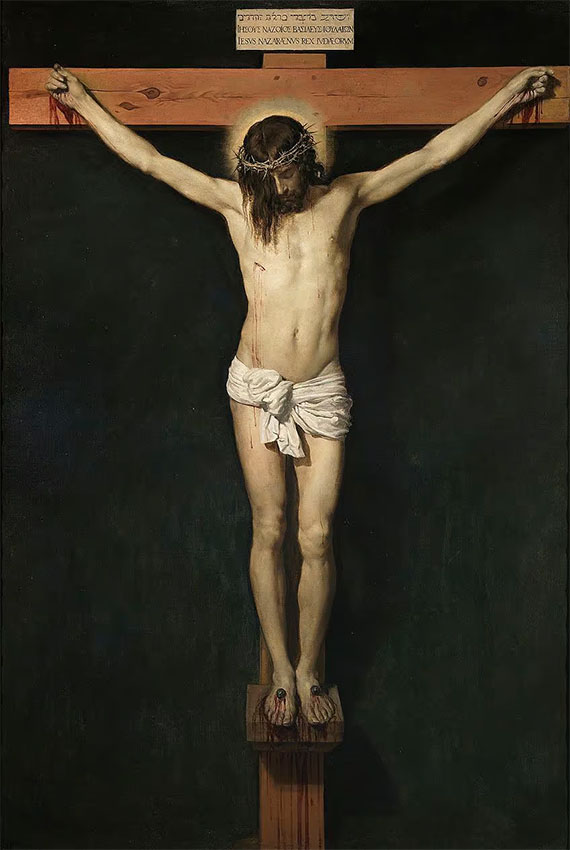
The artist's most famous religious painting has inspired many poems. Due to the lack of documentation, it is difficult to determine the date of the painting. Scholars believe the painting was finished after Velazquez returned from Italy. This is most likely between 1631-1632. The reclining head, the stylized face, and the calm body stance all show the influence of Classicist paintings.
Caravaggism is evident in the contrast between the background and the torso and in the artificial, bright lighting above the cross.
Paul Gauguin, The Yellow Christ (1889)
Paul Gauguin is a French painter who worked largely in the nineteenth century. He is now regarded as a prominent artist of Post-Impressionism. He expanded Impressionism and rejected its limitations.
This painting and another picture made by Gauguin called The Green Christ are considered to be the first and essential pieces of Symbolism art.
This painting shows Christ's Crucifixion in northern France in the 19th century. Women are gathered in prayer.

The composition is full of symbolism. For example, the jogger in the background represents the desire of people in the 19th century to return to a simpler, more primitive way of living. Gauguin's "synthetism", as the Yellow Christ demonstrates, goes beyond symbolism. This was made with bright colors, thick outlines, and flat planes.
Crucifixion by Francis Bacon (1933)
Francis Bacon was only 24 when he painted this controversial depiction. Bacon is one of only a few contemporary artists on this list who spent a great deal of time on religious works. His first work was a success, and proceeds from sales allowed him to finance his first solo exhibition, which was unfortunately poorly reviewed by the Times.
Bacon destroyed a number of his paintings, including some crucifixion images. Later, he would claim that the crucifixion pictures were amongst the few he regretted erasing.
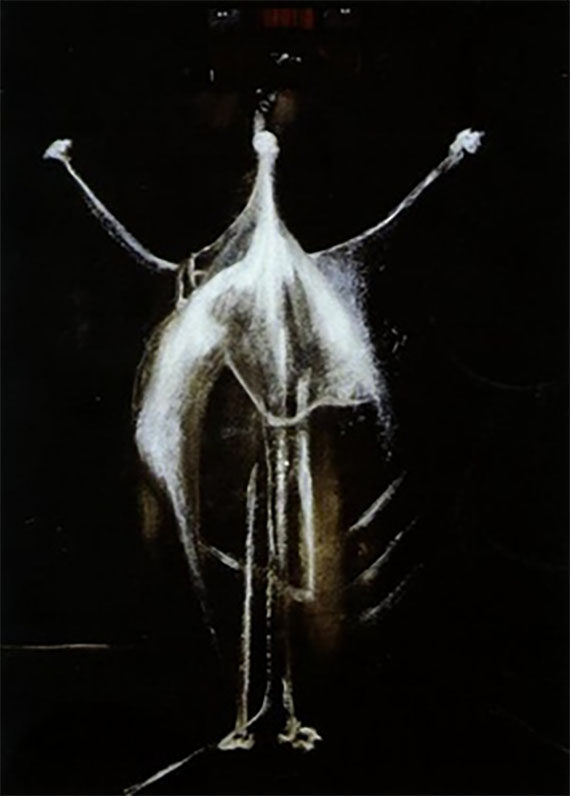
This work is difficult for the public to understand. However, when it's viewed within the context of
Bacon’s earlier work, its genius becomes evident.
This gloomy black, white, and grey painting shows an abstract human figure in white with its arms extended against a dark backdrop.
Space is defined by the lines that represent walls and floors and the horizontal bars of the cross. Jesus is shown as a stick figure with thin white arms wrapped around the cross and skinny legs. The head, hands, and feet are reduced to pale lumps.
Christ on the Cross by Salvador Dali
Salvador Dali is recognized internationally as the most important surrealist artist. It is called Christ of Saint John of the Cross due to its design which was inspired by the Spanish Franciscan John of the Cross made in the 16th century.
The triangle formed by the arms of Christ, the horizontal cross, and Christ's head is a circle. The triangle can be interpreted as a reference to the Holy Trinity. However, the circle could represent unity and the interconnection of all things. The artwork depicts the Crucifixion but is devoid of blood and nails.
Dali painted this painting after a dream where he feared that nails and blood might detract from Christ's image.

In a survey conducted in 2006, Christ Saint John of the Cross won the award for Scotland's favorite picture. It is one of the most famous pieces by a contemporary artist and is often considered the best religious painting of the 20th century.
Dal had Hollywood stuntman Russell Saunders hang from scaffolding above to observe the body from the required perspective and to imagine the forces of gravity on the body to construct the image of Christ. The bay of Port Lligat is where Dal lived at the time the painting was painted.
We have been learning about the most famous Jesus paintings. Jesus' portrait has evolved over the years. Jesus art is as diverse as the styles of painting. Jesus drawings can be found in all movements and styles. The art of Jesus Christ continues to inspire and fascinate people. We hope you enjoyed our list of the most famous Jesus paintings, which ranges from Jesus paintings depicting Christ with his disciples to Jesus paintings depicting him alone on the cross.
FAQs
Why was Jesus Depicted as a White European Man?
Jesus, born in Galilee in the Middle East region, had curly hair and brown eyes. He is often depicted as a blonde male with blue eyes and white hair. Christians in America and Europe often use their religion as an excuse to oppress people of color. Therefore, portraying Christ as a black male would have been a good fit for their purpose. The Nazis in Germany were the ones who portrayed Christ with an Aryan appearance and not his true Jewish one. Warner Sallman's iconic 1940 painting of Christ was reproduced on many items and objects. This image reinforced the false perception of Christ as a man of that time and place.
How Much are Jesus Paintings?
Leonardo da Vinci's portrait of Jesus was the most expensive painting sold. The painting called Salvator Mundi was sold for $475,000,000.
How Old is the Oldest Painting of Jesus?
The oldest Jesus painting was painted around 235 AD. The painting was found in Syria and shows Christ as a young man with no beard.
No Comments Yet...